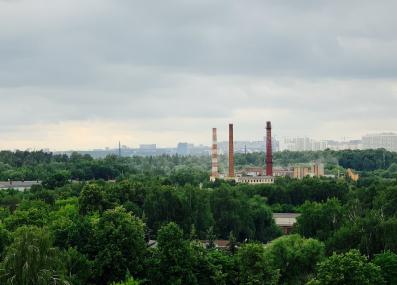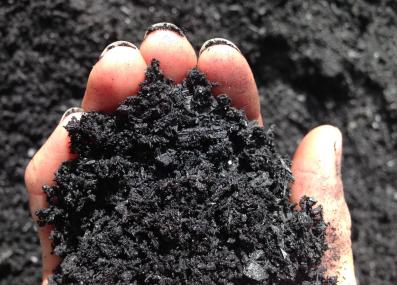Have a question?
When we remove carbon dioxide from the atmosphere, how long does it stay locked away?
In theory, we can remove CO2 from the air for thousands or even millions of years, which in terms of addressing climate change is effectively permanent. But carbon removal can also fail.
November 24, 2025
Since humanity started burning fossil fuels for energy, we have added roughly one trillion tons of climate-warming carbon dioxide (CO2) to our atmosphere. One could imagine a very literal way to deal with the climate change that has resulted: take the CO2 back out. For many reasons, though, this kind of “carbon removal” is a very tall order.
Among those reasons is that sucking out the CO2 is only the first step.
“You want to keep the CO2 out of the atmosphere for at least, let’s say, hundreds of years,” says Ruben Juanes, a geophysicist and MIT professor of civil and environmental engineering.1 Shorter-term storage, on the scale of decades, may usefully slow the pace of warming and buy time for more permanent solutions, but ultimately still leaves us to deal with the same CO2 in the midst of ongoing climate change.
Why might carbon removal fail to keep CO2 out of the air over centuries? It depends on how that CO2 is stored.
Today, the large majority of carbon removal relies on “natural climate solutions.”2 These use trees and other plants to draw CO2 out of the atmosphere, storing the carbon in their tissues and the soils below. If these living storage vessels are lost, says Evan Fricke, an ecologist and research scientist in the MIT Department of Civil and Environmental Engineering, the carbon is destined to return to the air.
“Some of the prominent failures of forest-based natural climate solutions include attempting to plant trees in ecosystems where they don't naturally occur,” he says. “And the trees simply die or burn up.”
So in the worst case, natural carbon removal may last only years or decades. But it can also be effectively permanent. Earth, after all, is home to forests that are tens of millions of years old.
Successful carbon removal, Fricke says, takes good planning and continued care. That can mean planting the right vegetation in the right ecosystems for long-term survival. It can be a matter of conservation, making sure a new or restored forest is not later cut down for timber or development. And it can also be quite active. Certain farming practices, for example, can help soils store extra carbon. But it is widely assumed that, to prevent that carbon from leaking back out, farmers must keep up these practices year after year.3
Still, Fricke says a well-managed project can handle some reversals. Even if wildfire razes a forest, a healthy ecosystem can regrow. The key is to pursue large-scale projects in diverse ecosystems, and prepare to manage them for the long term. Planners can also hedge against risks with “buffer pools” of land beyond what they need to meet their carbon storage goals.
“A leaf will fall and decompose,” says Fricke. “A tree might burn. But a forest landscape can be resilient for millennia. And so, as we implement these projects at scale, we should expect reversals in certain areas, but if we're getting our science right, the numbers for the entire portfolio should be quite predictable.”
Other approaches to carbon removal keep their carbon out of the elements. In “carbon capture and storage” (CCS), for example, CO2 is pumped underground. A nearly-pure stream of CO2 is pressurized for easier transportation, then injected into carefully chosen geological formations.4
This, says Juanes, is not so different from the way nature stores carbon underground, as oil and natural gas. “These hydrocarbons have been underground for millions of years, over geologic time,” he says. Pressurized CO2 is very similar, chemically and physically—so “in principle, it can be sequestered essentially indefinitely.”
The trick is in the execution. Hydrocarbons, Juanes points out, take millions of years to form, and the surrounding rock has ample time to react. CO2 injection applies pressure a lot faster. “So it is really crucial to understand how that overpressure can affect the safety or security of storage over the long term,” he says. The wrong choice of geology, or a too-aggressive injection, could let captured CO2 escape.
The world’s first CCS project began off the coast of Norway in 1996. Over the 30 years since, MIT Climate was unable to find any documentation of a CCS project losing a significant amount of CO2 to the atmosphere,5 but small leaks have been detected.6
There have also been several false starts and warning signs. “Very little of what happens underground happens exactly as we expect,” Juanes says, “from prospecting for minerals, to storage of CO2, to production of hydrocarbons.” CCS operators try to map the subsurface as well as possible before injection starts, but we cannot know everything about the rock in which CO2 will be stored.
As a result, Juanes says, “some projects have experienced unexpected behavior underground, and have had to either ramp down or shut down.” In 2011, for example, the In Salah project in Algeria halted early after researchers found signs that CO2 injection was cracking the rock and deforming the surface.7 As critics have noted, this is part of a pattern of projects underperforming.8
One could see this as a good sign for the permanence of CCS. Operators have spotted problems in advance, and adjusted or shut down without major leaks. But the challenges of dealing with pressurized CO2 underground add to the risks and costs. Are there more stable options?
A few types of carbon removal “mineralize” CO2 into limestone and other solids. This can be done by injecting CO2 into the right geologic formations, where it reacts with the underground rock. Or it can be done aboveground through “enhanced rock weathering,” speeding up chemical reactions between certain rocks and the CO2 in the air.
“In principle, if we can turn the CO2 into a solid, that's the most permanent form of storage,” says Juanes. This carbon is almost surely safe over tens of millions of years, until the slow forces of volcanism vent it back into the air.
But, he adds, all kinds of carbon removal can be effectively “permanent” if done right. As we choose which ones to pursue, we’ll have to weigh much more than their duration. Natural climate solutions are relatively cheap and ready to deploy. CCS can in principle handle large volumes of CO2 quickly. And all forms of carbon removal must compete with not emitting CO2 in the first place, by far the most “permanent” solution of all.
“Each of these has its trade-offs related to risks of reversals, the scale angle, the cost angle,” says Fricke. “Anyone who says that one of these is the silver bullet is probably lying to you. If there was a clear winner that we could implement at scale, without costs, we would have done it already.”
Thank you to Donald Yates of Perth, Australia, for the question.
Submit your own question to Ask MIT Climate
Get the latest from Ask MIT Climate monthly in your inbox
1 Juanes notes that 1,000 years is sometimes used as a shorthand measure of how long an effective carbon removal technique might keep CO2 out of the atmosphere, as in the Intergovernmental Panel on Climate Change’s Special Report on Carbon Dioxide Capture and Storage (2005). There is nothing magical about that number, and even the IPCC special report does not adopt or suggest it as an official target, but it may provide a helpful rough guide to thinking about the timescales relevant to the human experience of climate change. In other contexts, like in many of the carbon offset markets that let participants pay for projects that help address climate change, 100 years has become a frequently used benchmark.
2 Smith, Stephen, et al. The State of Carbon Dioxide Removal 2024 - 2nd Edition. https://doi.org/10.17605/OSF.IO/F85QJ.
3 See, e.g., Paul, Carsten, et al. “Carbon farming: Are soil carbon certificates a suitable tool for climate change mitigation?” Journal of Environmental Management 330 (2023). https://doi.org/10.1016/j.jenvman.2022.117142. And, Oldfield, E.E., et al. “Agricultural soil carbon credits: Making sense of protocols for carbon sequestration and net greenhouse gas removals.” Environmental Defense Fund and Woodwell Climate Research Center (2021). The description above is a greatly simplified story about the complex and incompletely understood process by which soils absorb and release carbon, and researchers have recently argued that some forms of agricultural soil carbon sequestration may persist for decades or longer without maintenance (see Dynarski, Katherine, Deborah Bossio, and Kate Scow. “Dynamic stability of soil carbon: Reassessing the ‘permanence’ of soil carbon sequestration.” Frontiers in Environmental Science 12 (2020). https://doi.org/10.3389/fenvs.2020.514701) and that soil carbon sequestration may usefully contribute to addressing climate change even over short timescales (see Leifeld, Jens. “Carbon farming: Climate change mitigation via non-permanent carbon sinks.” Journal of Environmental Management 339 (2023). https://doi.org/10.1016/j.jenvman.2023.117893).
4 The CO2 could be drawn from the atmosphere, through “direct air capture” machines that chemically strip CO2 from the air, but more often it comes from a power or industrial plant. One strategy, “bioenergy with CCS” or BECCS, takes a roundabout approach to carbon removal: Plants are grown, absorbing CO2 from the air; those plants are burned for energy; and the CO2 released when they’re burned is captured from the power plant and injected underground.
5 With some important caveats. Pipelines carrying CO2 for injection have leaked. In addition, most CO2 injected underground today is used for “enhanced oil recovery,” flushing hard-to-reach oil out of the ground, with CO2 storage only a secondary consideration. This practice has caused occasional “blowouts” in which oil and CO2 burst from a well. Pipeline leaks and blowouts can be fixed before significant volumes of CO2 are lost, but their safety risks can be very serious: A 2011 blowout near Tinsley, Mississippi, killed wildlife, and a 2020 pipeline leak near Satartia, Mississippi, led to dozens of hospitalizations. It is also the case that more than one CCS project has experienced internal leaks, where CO2 did not escape to the atmosphere but did end up in unexpected parts of the subsurface. In 2024, for example, the company Archer-Daniels-Midland paused its CO2 injections in Illinois after a corroded well allowed CO2 and brine into an unintended part of the formation, prompting concerns (fortunately not borne out) that CO2 would enter the groundwater and contaminate it.
6 See, e.g., Yang, Manping, et al. “Identification of CO2 leakage in an active CO2-EOR field, Songliao Basin, China.” Energy & Fuels 38 (2024). https://doi.org/10.1021/acs.energyfuels.4c03612. Yang, Changbing, et al. “Soil gas dynamics monitoring at a CO2-EOR site for leakage detection.” Geomechanics and Geophysics for Geo-Energy and Geo-Resources 3 (2017). https://doi.org/10.1007/s40948-017-0053-7. Wells, Arthur, et al. “The use of tracers to assess leakage from the sequestration of CO2 in a depleted oil reservoir, New Mexico, USA.” Applied Geochemistry 22 (2007). https://doi.org/10.1016/j.apgeochem.2007.01.002. There is reason to believe that enhanced oil recovery, as in the papers cited above, is more vulnerable to these leaks than CCS done purely for carbon storage, as oil fields may have abandoned, imperfectly sealed wells through which CO2 can escape.
7 Ringrose, Philip, et al. “The In Salah CO2 Storage Project: Lessons learned and knowledge transfer.” Energy Procedia 37 (2013). https://doi.org/10.1016/j.egypro.2013.06.551.
8 See, e.g., Robertson, Bruce and Milad Mousavian. “The carbon capture crux: Lessons learned.” Institute for Energy Economics and Financial Analysis (2022).









